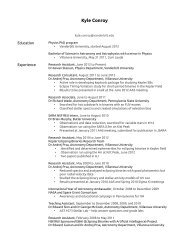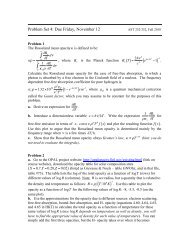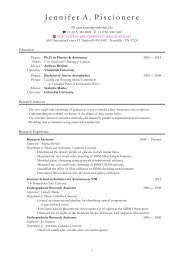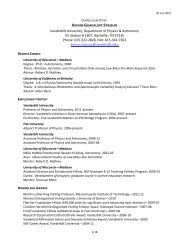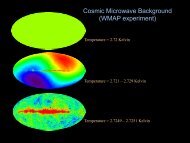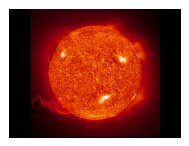Problem Set 2: Due Thursday, October 4
Problem Set 2: Due Thursday, October 4
Problem Set 2: Due Thursday, October 4
You also want an ePaper? Increase the reach of your titles
YUMPU automatically turns print PDFs into web optimized ePapers that Google loves.
<strong>Problem</strong> <strong>Set</strong> 2: <strong>Due</strong> <strong>Thursday</strong>, <strong>October</strong> 4 AST 352, Fall 2012<br />
<strong>Problem</strong> 1<br />
Calculate the gravitational potential energyΩ of a star in terms of its mass and radius<br />
(i.e., calculate the q factor in the expression −q GM 2<br />
), in the cases where the density<br />
R<br />
profile of the star goes like ρ ∝ r −1 and ρ ∝ r −2 (you can write the density as<br />
( ) −n where ρ 0<br />
and r 0<br />
are constants). What is the star’s total internal energy for<br />
ρ = ρ 0<br />
r r 0<br />
these two cases assuming that it is static and made up of gas that follows the ideal gas law<br />
(again, in units of GM 2 R)?<br />
<strong>Problem</strong> 2<br />
Assume a gas mixture with hydrogen, helium, and metal mass fractions of X=0.7,<br />
Y=0.28, and Z=0.02. You can assume that, for metals, the ratio of nuclear mass number<br />
to nuclear charge number is 2.<br />
a. Evaluate the mean molecular weight of the gas for a series of cases with different<br />
degrees of ionization, assuming the ideal gas law:<br />
- neutral gas<br />
- hydrogen ionized, helium singly ionized, metals neutral.<br />
- hydrogen and helium fully ionized, metals neutral.<br />
- fully ionized gas.<br />
b. Nuclear reactions will convert hydrogen to helium, and in later phases helium can be<br />
converted into carbon and oxygen. Assuming full ionization, compute the mean<br />
molecular weight when:<br />
- hydrogen is fully converted into helium (X=0, Y=0.98, Z=0.02)<br />
- helium is converted into metals (Z=1)<br />
<strong>Problem</strong> 3<br />
Show that the equation of state for an ideal gas is P = nkT even if the particles in the gas<br />
are highly relativistic.<br />
<strong>Problem</strong> 4<br />
a. Prepare a logρ − logT plot with the range: −10 ≤ log ρ ≤10 (x-axis) and<br />
4 ≤ logT ≤10 (y-axis). Write down the equations logT = f ( log ρ) that characterize the<br />
boundaries in this plane between different regimes in pressure. Specifically, where<br />
- the radiation pressure is equal to the ideal gas pressure<br />
- the ideal gas pressure is equal to the pressure of degenerate, non-relativistic electron gas<br />
- the pressure of degenerate, non-relativistic electron gas is equal to the pressure of<br />
degenerate, relativistic electron gas.<br />
Adopt: X=0, Y=1, Z=0 and assume that the gas is fully ionized.<br />
Plot these three curves on your logρ − logT plot and label the regions on the plot where<br />
each type of pressure dominates.
. The total gas pressure can be written as P tot<br />
= P rad<br />
+ P ion<br />
+ P e<br />
, where P rad<br />
is the<br />
radiation pressure, P ion<br />
is the ideal gas ion pressure, and P e<br />
is the total electron pressure.<br />
You can approximate the electron pressure as the sum in quadrature of the nondegenerate<br />
and degenerate components: P e<br />
=<br />
P 2 2<br />
( e,nd<br />
+ P e,d ) 1 2 , and assume that the<br />
degenerate electrons are non-relativistic. Write a computer routine that computes the<br />
total gas pressure for a given gas density ρ, temperature T , and mean molecular weights<br />
for ions and electrons µ i<br />
and µ e<br />
. Use your routine to make a plot of total gas pressure<br />
logP tot<br />
versus density logρ for the following values of temperature: logT = 5,6,7,8,<br />
assuming the mean molecular weight from part a.<br />
<strong>Problem</strong> 5<br />
Important quantities of neutral (He I), singly ionized (He II), and doubly ionized (He III)<br />
helium can be present at the same time. For an ideal non-degenerate pure helium gas,<br />
write down the set of equations to solve for the ionization fractions y I<br />
,y II<br />
, y III<br />
of He I, He<br />
II, and He III. You can treat the ionization potentials ( χ II<br />
,χ III ) and partition functions<br />
( G I<br />
,G II<br />
,G III ) as known arbitrary functions.



